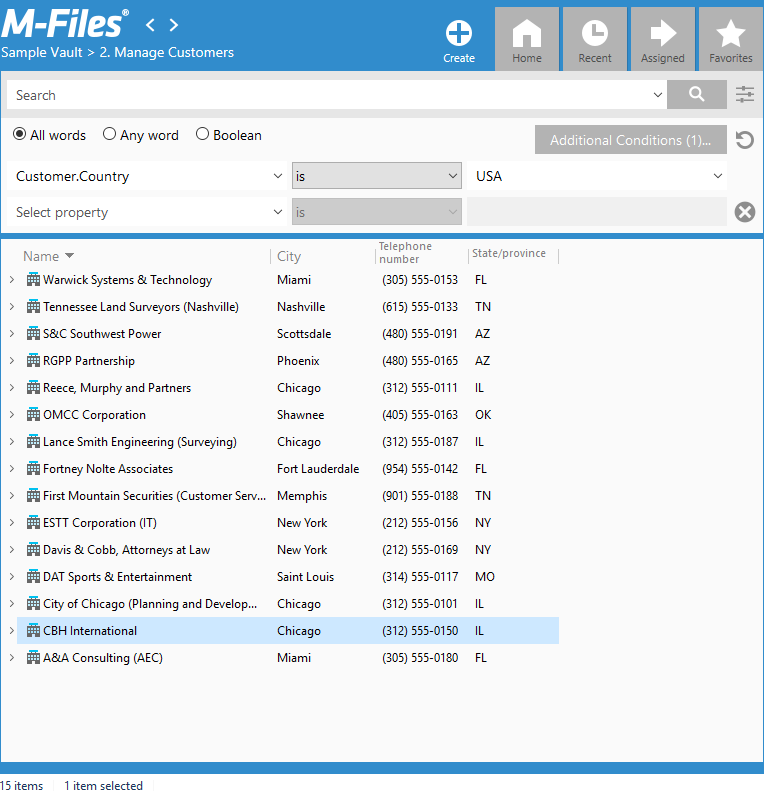Quick Search
The M-Files Desktop quick search looks for objects that contain the search word in the metadata or file contents. Normally, M-Files searches for matches in both, but you can change the setting on the Filters tab. M-Files remembers your selection until you close the window or log out. See Filters Tab for more ways to refine your search.
Video: Quick Search Functionality
In the search field, enter a search string that has to do with the object, such as the title, the login account of a person who has edited it, or a customer related to it, and click the search button. The search string does not need to be a whole word — you can truncate the word by using an asterisk. For example, when you search for data in the Demo Vault with the search string specific*, you will find a document named Technical Specifications, because the name contains the string searched for. For a comprehensive list of different operators and special characters you can use in your search query, see Operators and Special Characters.
- using quotation marks or other operators and special characters, such as AND
- using search options for quick search
- using a more accurate search term by adding keywords or using more focused keywords
- refining your search using the advanced search features on the Filters tab
To search for a particular word form, disable the Look for different inflected forms of the words in Quick Search option in the Additional Conditions dialog. This option is enabled by default. When you do this to search for, say, the word "corporation", the search results include only those objects that match this exact word, not corporate, incorporated, and so on.
Words and phrases searched for are stored in the search drop-down menu, making it easy to repeat recent searches.

In the quick search, you only need to enter the search word.
Search options for Quick Search
Click the search options button ( )
to the right of the Quick Search field to expand the search options. When the button is clicked,
these options are shown:
)
to the right of the Quick Search field to expand the search options. When the button is clicked,
these options are shown:
Some search conditions operate differently with different search engines. Refer to dtSearch, Micro Focus IDOL, and M-Files Smart Search - Differences in M-Files Search.
Search type
Select one of these options to specify the way your search queries are matched:
|
All words |
Matched objects contain all the specified search words. |
|
Any word |
The search will return all objects that contain at least one of the specified search words. |
|
Boolean |
The search lets you use more specific search phrases and different operators, for example AND or NOT. For the list of operators, see Boolean operators. Note: Boolean search is available in vaults that use dtSearch or Micro Focus IDOL as the search engine.
|
Property condition
Each object has property values that can be used as search criteria. The value of the property Project can be for instance Hospital Expansion (Florida). If you perform a search with these values, the search returns all the documents in which the Project property contains the value Hospital Expansion (Florida).
You can define a property condition by selecting a property, a condition, and a property value
using the drop-down menus in the search options section. You may define additional
property conditions by clicking the plus icon (![]() ).
).
Subordination of search criteria
You can easily specify search criteria by utilizing their subordination, so the options shown in the lists are filtered on the basis of other list choices. For example, if you have selected a certain workflow as the search criterion, the state options are filtered in such a way that only the states related to your selected workflow are visible and selectable. Corresponding filtering will be performed automatically for other interdependent value lists as well. For example, contact persons are filtered by customer if these value lists have a hierarchical relationship.
Subordinate search criteria can be used with the "is" operator. In the Additional Conditions dialog, the operator "one of" can also be used.
Indirect searches
You can specify search criteria also by means of property relationships, which means that the object itself need not have the property in question. Instead, the property selected as the search criterion is in this case the property of a related object.
By using indirect search, you can, for example, find agreements related to a specific country; even if the Country property has not been defined for the actual agreement, it is enough if it can be found via a customer associated with the agreement. In this case, the search criterion is specified as Customer.Country.
You can specify these indirect search properties by clicking the plus-sign button in the list and then selecting the property of a related object to be used as the search criterion. In the example below, Customer was selected from the list first, and then the customer's Country property, which resulted in the search criterion with a period, "Customer.Country", being displayed in the search field.
By using additional conditions, you can create three-level indirect search criteria.

